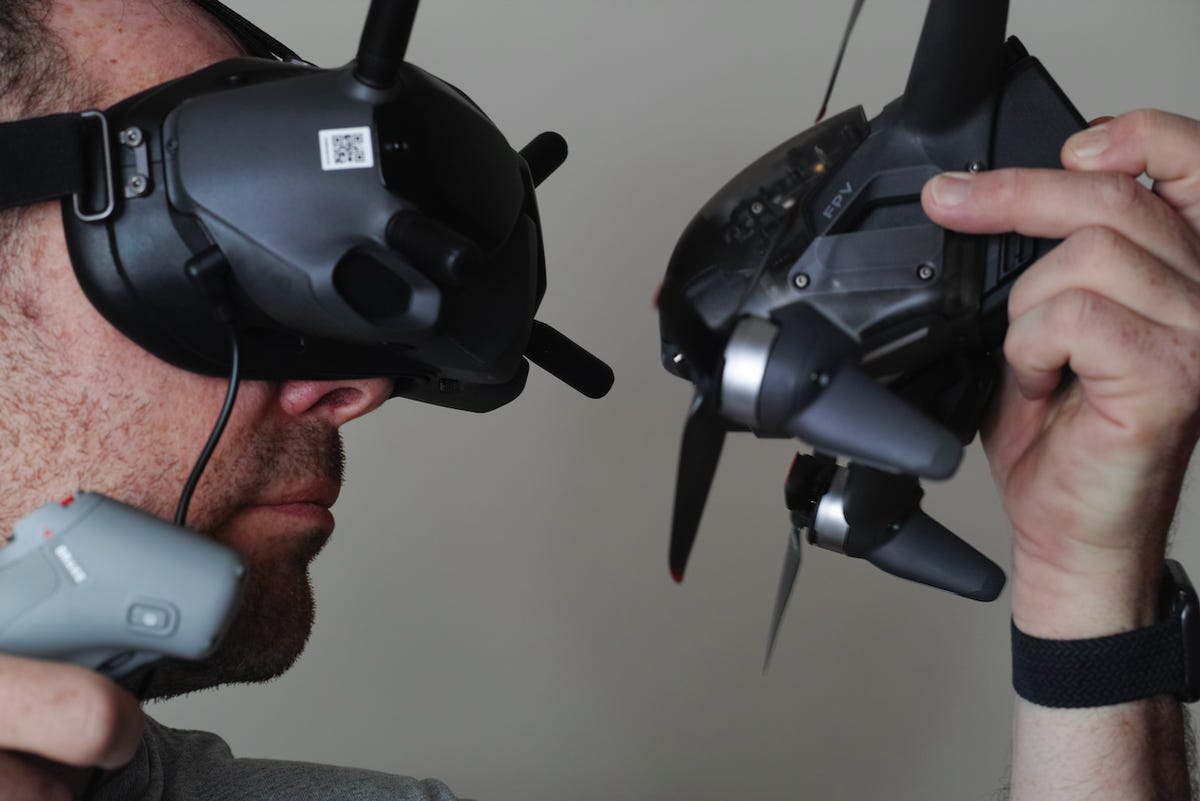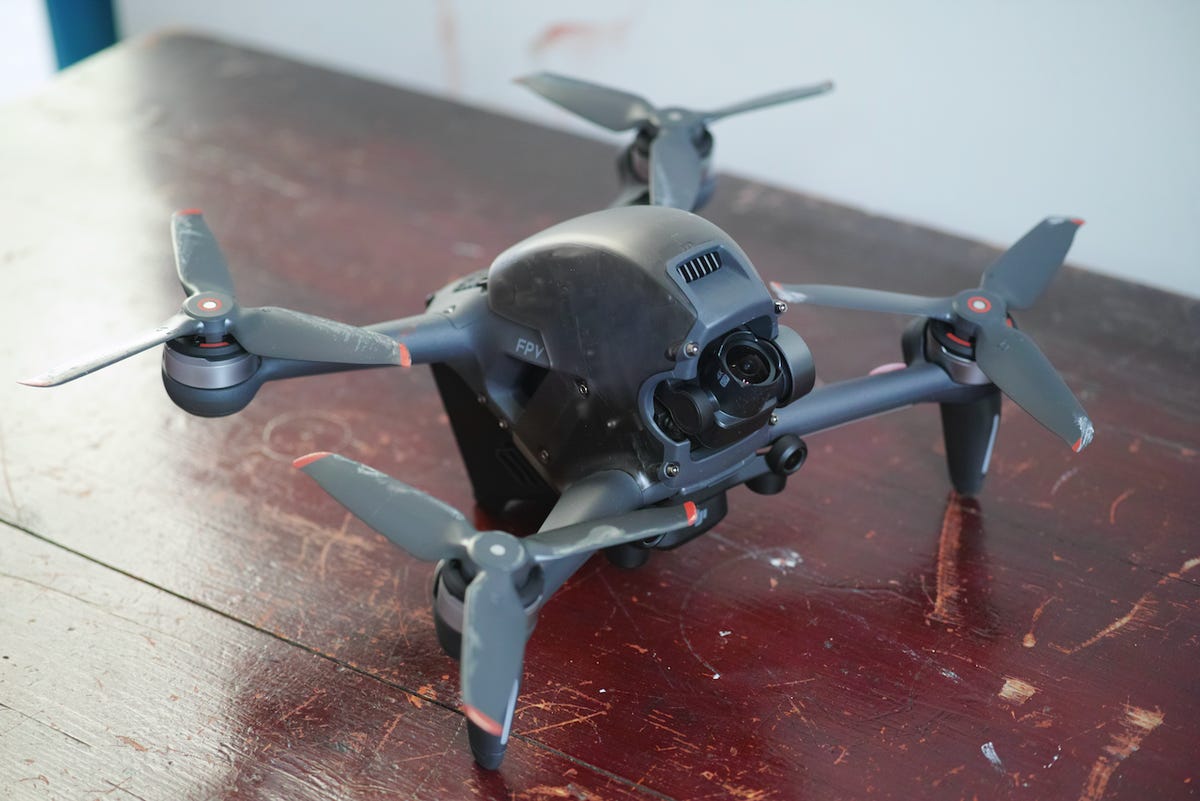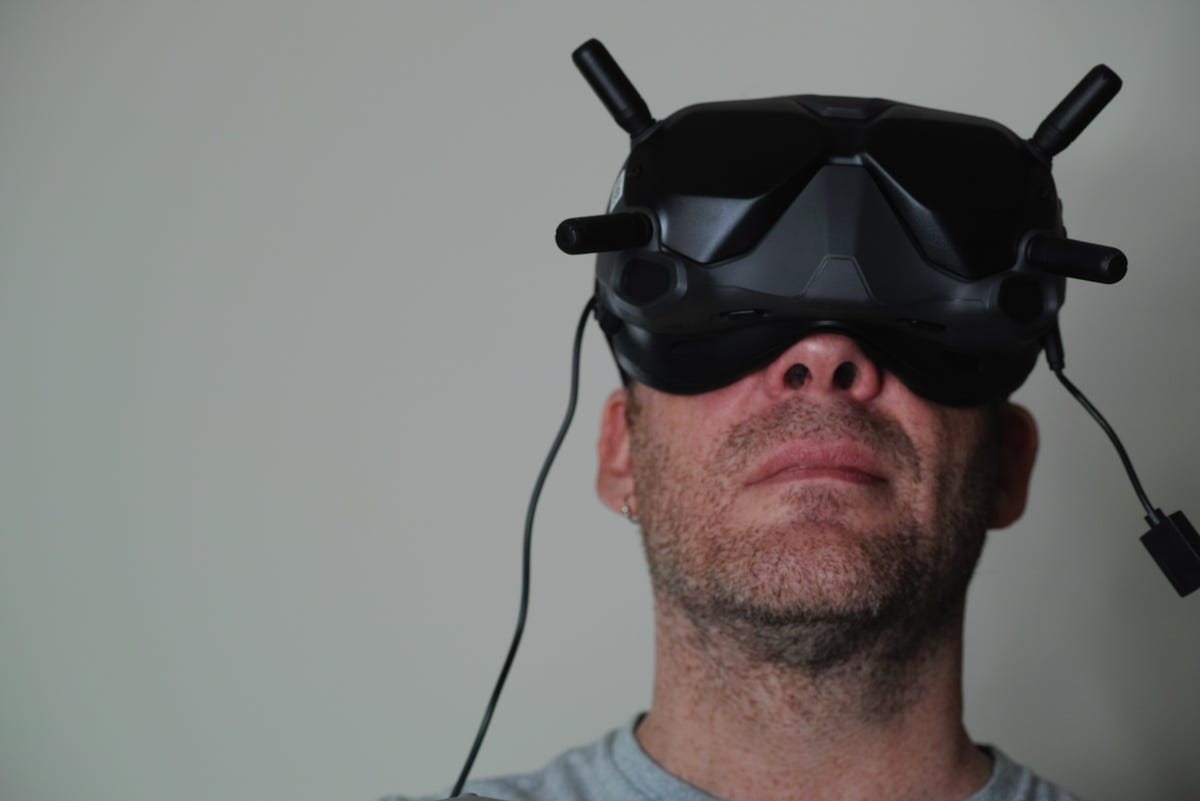
Up close and personal: The FPV is the first DJI drone with accompanying goggles to experience the live feed in VR form, and a trigger-based motion controller.
A do-it-yourself market in technology always establishes not just inventions, but also a culture. That’s certainly the case for the drone racing culture that has sprung up in the last five years, where enthusiasts cobble together drones from parts, complete with virtual reality glasses and audio-video systems to send the live feed from their drones to the goggles, to give one the feeling of racing at two hundred miles an hour through backyards and living rooms. There’s tons of footage of competitive races at blogs such as The Tiny Whoop.
Hence, stepping into that marketplace, for any consumer vendor, is a challenge, because it means taking on a culture.
That’s the challenge that DJI, one of the world’s most prominent drone makers, has set for itself with its first entrée into what is called FPV drones, for “first person view.” With a shape more bug-like than any of those, DJI’s FPV went on sale Tuesday for $1,299, sporting a set of virtual reality goggles.
The company is betting that the time has come for the hobbyist market to mature to a professionally-developed, integrated product that comes ready-to-use, for those who don’t want to be design and build their own virtual reality drone from scratch.
DJI has dominated both commercial drone development for things such as cinematic and rescue use, and also consumer piloting. The company’s Mavic Air 2 is a very sleek, foldable device that has a superior wireless communciations system and camera. The Mavic Mini is the ultimate in pocketable, high-performance drones.
To the world of FPV, DJI promises many pluses. Aside from its pre-built, out of the box convenience, the device replaces slow, unreliable analog video transmission with digital; it offers simpler modes of operation for novice users that put in place many safety measures, including obstacle avoidance; and it all comes with the company’s dedicated wireless control channel system, OcuSync, to make for a more reliable control process.
The FPV drone in many respects behaves similar to the Mavic Air 2 or Mini. The aircraft, the remote controller, and the goggles all turn on with the same familiar button combination as before, first pressing the power once, then pressing and holding it. The FPV has a transmission range from the included remote controller that tops out at six miles, or 10 kilometers, the same as the Mavics. The joysticks on the RC operate to control ascent and rotation and pitch and roll in the same familiar way. And the assembly of propellers is familiar. Charging the drone’s removable lithium-polymer battery and the RC is a familiar process of plugging them into the AC adaptor. A companion DJI Fly app connects to the goggles via USB-C this time, instead of connecting to the remote controller. And a micro-SD slot takes a card for storing video and photos, as usual. A handy shutter release on either the RC or the goggles will take a picture or start or stop filming, and can switch between the two modes with a long press.

The FPV gets a top speed of 87 miles per hour, and captures 4K video at 60 frames per second.
And then there are dramatic differences, starting with the headset, the first time DJI has offered a VR set of goggles with a drone. The FPV has the abilty to transmit the live video feed to the goggles at 120 frames per second, where the image will be spread across the eye sockets of the helmet in a 150-degree field of view. The live feed also shows up on the smart phone in the DJI Fly app at the same time that it appears in the goggles.
The heart of the FPV drone is really in the speed and control. FPV drones are known for speed, with some hand-built models getting top speeds of 200 miles per hour. Consumer drones have tended to be well below that. The Mavic Air 2, for example, tops out at 42 miles per hour.
For the FPV, DJI has consdirably stepped things up. The FPV has three modes, normal, sport, and manual. Normal mode limits the drone to 50 kilometers per hour, or 31 miles an hour. In Sport mode, that increases to 97 kilometers per hours, or 60 miles an hour. In Manual, one can go as fast as 140 kilometers per hour, or 87 miles an hour. The FPV can go from zero to 60 miles per hour in two seconds.
The functions of flying and capturing video and feeding the goggles, however, will take a bigger toll on the 2000-milli-amp-hour battery, which tops out at 20 minutes of flight time on a full charge. That’s considerably less than the 34 minutes you’ll get with the Mavic Air 2’s 3,500-milli-amp-hour battery.

The goggles are designed with a 150-degree field of view, and receive the video feed from the FPV at 120 frames per second.
Considering that many people may be new to drones and also new to VR, DJI has sought to provide more cushioning for some users. The FPV automatically starts up in “normal” mode, the most limited, and slowest form, and can be switched to either sport or manual with a flick of a button on the controller. The iOS version of DJI Fly comes with a flight simulator, to give new users a chance to experience take off and landing before flying the real thing.
A separate motion controller in the familiar guise of a VR trigger-based joystick is avaible as an option, costing $199. This controller substitutes gestures for what were joystick actions on the remote controller. Moving the motion controller to the right or left rotates the aircraft, while noving the nose of the controller up or down will control ascent and descent, and pressing the trigger accelerates.

A motion controller, sold separately for $199, completes the VR experience, mirroring the gesture-based approach to control, as an alternative to the traditional joystick-and-gamepad controller.
Given the short life of the included Lithium-Polymer battery, you may well want to purchase and additional one or two, at $159 each. The familiar Fly More kit that DJI sells for every drone includes two batteries and a charging hub for $299.
In ZDNet’s initial testing, the set up process and interaction between goggles and remote controller and smartphone were fairly straightforward, though some software gotches popped up, such as losing the feed from the aircraft to the goggles on the second power-on.
ZDNet will be testing the FPV in the coming weeks and will offer a comprehensive review of this new experience. Fasten your seat belts, it’s a new realm in dronage.






















